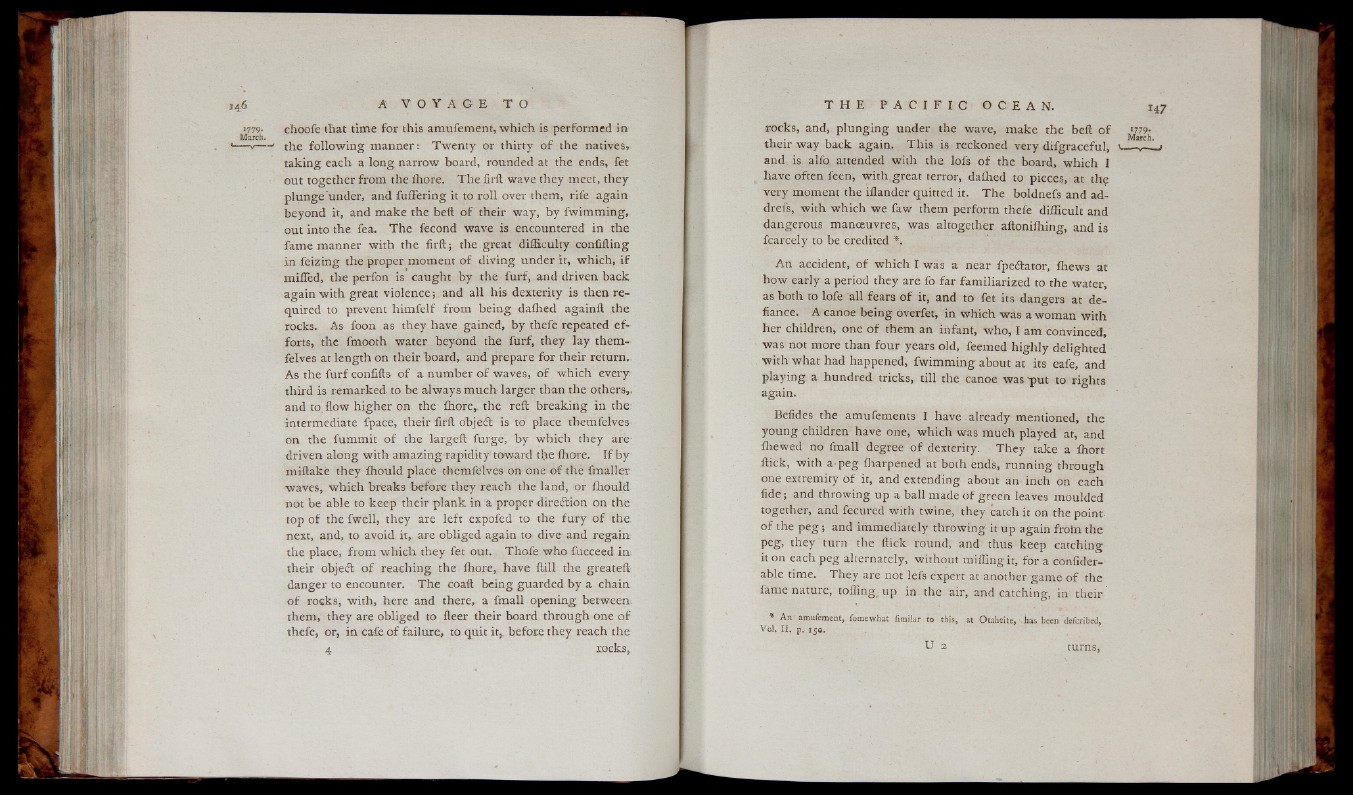
*779- choofe tiiat time for this amufement, which is performed in
March'. | •
—v— the following manner: Twenty or thirty o f the natives»
taking each a long narrow board, rounded at the ends, fet
out together from the ihore. The firft wave they meet, they
plunge under, and fuffering it to roll over them, rife again
beyond it, and make the beft o f their way, by fwimming,
out into the fea. The fecond wave is encountered in the
fame manner with the firft; the great difficulty confifting
in feizing the proper moment o f diving under it, which, i f
milled, the perfon is caught by the furf, and driven back
again with great violence; and all his dexterity is then required
to prevent himfelf from being daihed againft the
rocks. As foon as they have gained, by thefe repeated efforts,
the fmooth water beyond the furf, they lay them-
felves at length on their board, and prepare for their return.
As the fu rf confifts o f a number o f waves, o f which every
third is remarked to be always much larger than the others,,
and to. flow higher on the ihore,. the reft breaking in the-
intermediate fpace, their firft dbjedt is to place tbemfelves-
on the fummit of the largeft furge, by which they are-
driven along with amazing rapidity toward the ihore. If by
miftake they ihould place themfelves on one o f the fmaller
waves, which breaks before they reach the land, or ihould
not be able to keep their plank in a proper direction on the
top o f the fwell, they are left expofed to the fury o f the.
next, and, to avoid it, are obliged again to dive and regain
the place, from which they fet out. Thofe who fucceed in
their objeft o f reaching the ihore, have flill the greatell
danger to encounter. The coaft being guarded by a chain,
o f rocks, with, here and there, a fmall opening between,
them, they are obliged to fteer their board through one o f
thefe, or, in cafe o f failure, to quit it,, before they reach the
4 rocks,
rocks, and, plunging under the wave, make the beft o f ¿779^
their .way back again. This is reckoned very difgraceful, ' ~_j
and. is alfo attended with the lofs o f the board, which I
have often feen, with great terror, daihed to pieces, at the
very moment the iflander quitted it. The boldnefs and ad-
drefs, with which we faw them perform thefe difficult and
dangerous manoeuvres, was altogether aftoniihing, and is
fcarcely to be credited *.
An accident, o f which I was a near fpe&ator, ffiews at
how early a period they are fo far familiarized to the water,
as both to lofe all fears o f it, and to fet its dangers at defiance.
A canoe being overfet, in which was a woman with
her children, one o f them an infant, who, I am convinced,
was not more than four years old, feemed highly delighted
with what had happened, fwimming about at its eafe, and
playing a hundred tricks, till the canoe was "put to rights
again.
Befides the amufements I have already mentioned, the
young children have one, which was much played at, and
ffiewed no fmall degree o f dexterity. They take a ffiort
ftick, with a-peg iharpened at both ends, running through
one extremity o f it, and extending about an inch on each
fide; and throwing up a ball made of green leaves moulded
together, and fecured with twine, they catch it 011 the point-
o f the p e g ; and immediately throwing it up again frotn the
peg, they turn the ftick round, and thus keep catching
it on each peg alternately, without miffing it, for a confider-
able time. They are not lefs expert at another game o f the
fame nature, tolling^ up in the air, and catching, in their
* An amufement, fomewhat. ftmilar to this, at Otaheite, ^ has been defcribed, .
Vol. II. p, 150.